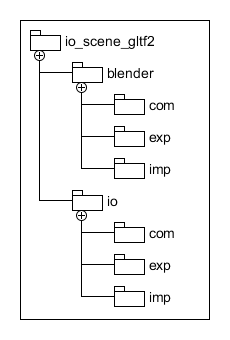Under development
Until this project is ready, please use the separate export and import addons.
Developed by UX3D and Julien Duroure, with support from the Khronos Group, Mozilla, and Airbus Defense & Space.
Official Khronos Group Blender glTF 2.0 importer and exporter.
This project contains all features from the previous exporter, and all future development will happen on this repository. In addition, this repository contains a Blender importer, with common Python code shared between exporter and importer for round-trip workflows. New features are included or under development, but usage and menu functionality remain the same.
Major change compared to the current Khronos glTF 2.0 exporter is, that the Blender glTF importer and exporter code is maintained in one place. Installation is simpler and the user experience regarding the menu functionality the same. On the development side, synergies do exist by sharing common code between the importer and exporter. Having the solution in one place, this also allows importing and exporting glTF files like loading and saving them.
The shared code base is organised into common (Blender-independent) and Blender-specific packages:
This structure allows easier Blender 2.79 to 2.80 updates, and enables common code to be reused by third-party Python packages working with the glTF 2.0 format.
The main importer and exporter interface is the Python glTF scene representation.
Blender scene data is first extracted and converted into this scene description. This glTF scene description is exported to the final JSON glTF file. Any compression of mesh, animation, or texture data happens here.
For import, glTF data is parsed and written into the Python glTF scene description. Any decompression is executed in this step. Using the imported glTF scene tree, the Blender internal scene representation is generated from this information.
The Khronos glTF 2.0 importer and exporter is not available in the Add-ons tab by default, and must be downloaded from this repository and manually installed. Copy the addons/io_scene_gltf2 folder into the scripts/addons/ directory of the Blender installation, then enable it under the Add-ons tab.
Documentation coming soon.
Blender glTF I/O no longer requires the use of custom Cycles nodes when exporting PBR materials. Properties of the Principled BSDF node will be used automatically, as supported by the glTF 2.0 format. Only simple node inputs like Image Textures are currently supported, and complex node graphs are ignored.
Several companies, individuals, and glTF community members contribute to Blender glTF I/O. Functionality is added and bugs are fixed regularly. Because hobbyists and professionals using Blender glTF I/O rely on its stability for their daily work, continuous integration tests are enabled. After each commit or pull request, the following tests are run:
- Export Blender scene and validate using the glTF validator
- Round trip import-export and comparison of glTF validator results
These quality-assurance checks improve the reliability of Blender glTF I/O.



